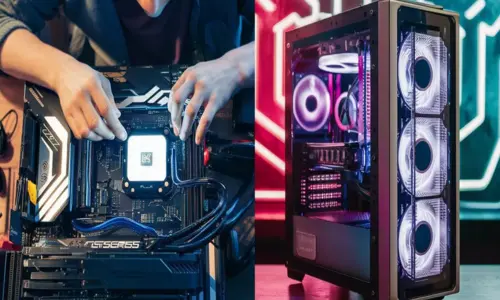How to Build a Custom PC for Gaming or Work in 2024
Whether you’re a gamer seeking high-end performance or someone who needs a workstation for professional use, assembling your own PC gives you the freedom to choose components tailored to your specific needs. As technology continues to evolve, 2024 presents exciting new options for custom PC builders.
In this guide, we’ll walk you through the steps of building a custom PC for both gaming and work in 2024, including selecting the right components, understanding your needs, and assembling everything like a pro.
1. Determine Your PC’s Purpose
Before you start building, it’s crucial to understand your primary use case: are you building a PC for gaming, work, or a combination of both? While gaming PCs are designed to prioritize high-performance graphics and speed, work PCs may need more CPU power for tasks like video editing, 3D modeling, or programming.
- Gaming PC: Focus on powerful graphics cards, high refresh rates, and sufficient cooling for long gaming sessions.
- Workstation: Prioritize multi-core processors, large amounts of RAM, and storage optimized for speed and reliability.
If you’re building a hybrid machine, you’ll need a balance of both performance and efficiency, ensuring it handles gaming and professional workloads.
2. Choose the Right Components
Now that you’ve identified the purpose of your custom PC, the next step is selecting the appropriate components. In 2024, hardware has advanced considerably, offering more performance options than ever.
CPU (Central Processing Unit)
The CPU is the brain of your PC, and it’s critical to choose one that suits your needs:
- For Gaming: High clock speeds and single-core performance are key. Consider the Intel Core i9-14900K or AMD Ryzen 9 7900X, both offering excellent gaming performance.
- For Work: Multi-core processors are ideal for handling demanding tasks like rendering or running multiple applications. Look for options like the AMD Ryzen Threadripper PRO 7000 series, which offers up to 64 cores.
In 2024, both Intel and AMD have introduced CPUs with hybrid architecture, mixing performance and efficiency cores, making them versatile for both gaming and work tasks.
GPU (Graphics Processing Unit)
The GPU is crucial for gaming, and in 2024, we’re seeing incredible advancements in both NVIDIA and AMD graphics cards:
- For Gaming: The NVIDIA RTX 5090 and AMD Radeon RX 8900 XT are top-tier choices, offering 4K gaming at high frame rates, ray tracing, and AI-enhanced visuals.
- For Work: If you’re working with 3D modeling, video editing, or AI workloads, consider professional-grade GPUs like the NVIDIA RTX A6000 for high-end rendering tasks.
Make sure to pair your GPU with a compatible monitor to take full advantage of technologies like ray tracing, high refresh rates, and HDR.
RAM (Random Access Memory)
RAM plays a vital role in how fast your PC performs multitasking and running applications.
- For Gaming: 16GB of DDR5 RAM is the current standard for most gaming PCs in 2024. However, 32GB is recommended for those who want to future-proof their build.
- For Work: If you’re dealing with heavy workloads like video editing or 3D rendering, consider 32GB or even 64GB of DDR5 RAM for smoother performance.
DDR5 memory is the go-to choice in 2024, offering higher speeds and improved efficiency compared to DDR4.
Storage: SSD vs. HDD
Speed and capacity are the two key factors when selecting storage.
- For Gaming: A 1TB NVMe SSD should be your minimum for fast load times and quick access to game files. The Samsung 990 Pro is a solid option, offering blazing-fast read and write speeds.
- For Work: Depending on your workflow, you may need more storage space. A 2TB or 4TB SSD, along with a secondary HDD for mass storage, is ideal for handling large video files, databases, or 3D models.
PCIe Gen 5 SSDs are becoming the norm in 2024, providing incredible speeds that make a noticeable difference in both gaming and professional tasks.
Motherboard
Choosing the right motherboard ensures compatibility between your components. In 2024, motherboards offer support for newer technologies like DDR5 RAM, PCIe Gen 5, and advanced cooling solutions.
- For Gaming: Look for motherboards like the ASUS ROG Crosshair X670E or MSI MPG Z790 that support high-speed data transfers and overclocking.
- For Work: If you need more PCIe lanes for GPUs or other expansion cards, consider workstation boards like the ASUS Pro WS WRX80E, which offer additional slots for future upgrades.
Be sure to check the chipset compatibility with your CPU to avoid any bottlenecks.
Power Supply Unit (PSU)
The PSU powers your entire system, so getting one with enough wattage is crucial. Calculate your power needs based on the components you choose.
- For Gaming: A 750W to 850W PSU is ideal for high-end gaming PCs, especially if you’re using power-hungry GPUs like the RTX 5090.
- For Work: Workstations may require even more power, particularly if you’re running multiple GPUs. In that case, consider a PSU with 1000W or more.
Opt for a PSU with an 80 Plus Gold or Platinum rating to ensure energy efficiency and reliability.
Cooling System
Effective cooling is essential, especially if you plan to overclock your CPU or GPU.
- For Gaming: Air coolers like the Noctua NH-D15 or liquid coolers like the Corsair iCUE H150i Elite are excellent choices for maintaining stable temperatures during long gaming sessions.
- For Work: If you’re building a high-performance workstation, opt for custom liquid cooling solutions to keep temperatures low, even under heavy workloads.
A well-ventilated case is also important. Ensure your case supports sufficient airflow and has enough space for all your components.
3. Assemble Your PC
Once you’ve gathered all the necessary components, it’s time to assemble your custom PC. While this process may seem daunting, it’s quite straightforward with a bit of patience and attention to detail.
- Prepare Your Workspace: Make sure you have a clean, spacious area to work in, and gather all the tools you’ll need, such as a screwdriver and thermal paste.
- Install the CPU and RAM: Begin by placing your CPU into the motherboard socket and securing it with the provided latch. Then, insert your RAM into the corresponding slots.
- Mount the Motherboard: Once the CPU and RAM are installed, carefully place the motherboard into the case, securing it with screws.
- Add Storage and GPU: Install your SSD and any additional hard drives. Then, mount your GPU into the PCIe slot.
- Connect Power Supply: Finally, plug in your PSU and ensure all the power connections are correctly attached to the motherboard, CPU, GPU, and storage devices.
After everything is connected, boot up your PC, install your operating system (such as Windows or Linux), and update all your drivers.
4. Test and Optimize
Once your custom PC is up and running, it’s time to test its performance. Run benchmarking tools like 3DMark or Cinebench to evaluate your system’s capabilities and ensure everything is working optimally.
For gaming, you may want to tweak in-game settings or overclock your GPU for maximum performance. For workstations, stress-test your system with intensive workloads to confirm stability.
Conclusion
Building a custom PC in 2024 allows you to tailor your machine to your specific needs, whether for gaming or work. With cutting-edge components and evolving technologies, you can create a powerful system that handles any task you throw at it. The key is careful planning, selecting the right parts, and assembling them with care.
By following this guide, you’ll have a custom-built PC that performs exceptionally well and is future-proofed for years to come.







